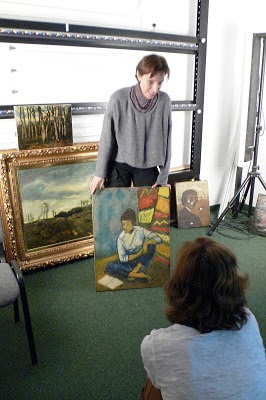by Catherine Schofield Sezgin
On her trip to Budapest earlier this month, ARCA’s Director of Public and Institutional Relations, Colette Loll Marvin, toured the facility of
Tondo, Inc., a firm specializing in complex painting analysis that contributes to attributions and forgery research. Tondo’s Chief Executive Officer Zsófia Végvári led Marvin through a series of complex tests used to determine the authenticity of a suspected Picasso painting recently discovered by a buyer in the Middle East. The testing can tell the age of the inorganic components, which will be used, along with the judgements of art historians, to make a determination of the authenticity, Végvári told Marvin.
Végvári founded Tondo in 1998. For the past 10 years, Tondo has provided services to cultural institutions and art collectors with an arsenal of mobile, high-tech equipment for analyzing art works. The Complex Painting Analysis Method (CPAM) combined five techniques to help authenticate paintings.
“So far art historians have used only subjective methods to define oil paintings,” said Végvári in a follow-up email. “By using the CPAM methods we offer objective applications instead of these subjective methods. On the auction market, pictures by famous painters change owners for a high price. These highly valuable paintings have been investigated with objective technologies such as X-ray, XRF, and luminescence examinations in a few cases only. However, most of the results do not increase the credibility of the auction market, but facilitate the restoration phase. After investigating the hidden layer and the metal-content of the painting, we can tell whether or not it was repainted in the past. The CPAM offers so- called 'genetic fingerprint' conditions of paintings based on physical and chemical investigations.”
According to Tondo, the technologies used in the Complex Painting Analysis Method: multispectral photography; X-Ray; microscopy; X-ray Fluorescence - Spectroscopy (XRF) examination; and a 3D white light scanner.
With multispectral photography, Tondo uses a normal light at an angle to the painting to examine brush strokes, crackling, and the artist’s signature, Végvári explained. An infrared light can reveal the underdrawing in a painting, she said. “Some pigments, such as lead white or artificial ultramarine, become transparent on infrared shoot,” Végvári explained. "It is clearly seen where different pigments were used."
Ultraviolet light can detect later restorations that appear darker than the aged original varnish layers. “It’s possible to identify any retouchings on top of an aged varnish, since oil paint and newer varnish do not fluoresce under ultraviolet light,” Végvári explained.
“A low radiation x-ray is one of the most important part of our investigation methods,” Végvári said. “X-ray can give information about an artist’s painting techniques, pigments, and under-paintings. The x-ray technique primarily records the structural elements of a painting as it shows the pigment characterizations. An x-ray can also reveal a painting hidden underneath the visible painting.”
According to Végvári, microscopy can give an amazing amount of information about a painting’s structure, based on cross sectional analysis or pigment sampling. In an invasive technology, a sample is cut from the canvas of 1-2 millimeters to show the layers of paint colors and varnish. The cross sectional analysis presents information about the repainted areas and colors as the chronology of the artist’s working methods, including restoration work. Inside of the layers most of the grains of the pigments can be identified. The pigments sampling helps to identify the age of the paint layer based on the size, characterisation, and the components of the pigment grains.
An X-ray Fluorescence - Spectroscopy (XRF) examination can identify most of the pigments used in paint, Végvári explained, and can be compared to known materials and palettes used during certain historical periods and geographical areas. The XRF spectroscopy can date objects and can reveal forged works when the chemical compounds of the paints do not match the alleged date of the artwork. For example, Végvári said, titanium white would not be in a painting in 1912. Titanium white was not available as an artist's pigment until 1924.
"The combination of XRF and microscopy allows 'diagnosing' an artists’ palette," Végvári said. "It is extremely important to make special database about colors used by each artist."
The three-dimensional surface of the artworks can be recorded with the accuracy of microns with a 3D white light scanner manufactured by Breuckmann GMBH in Germany. With this investigation method, according to Végvári, the condition of the paintings, and the distortion of the support or the brushstrokes can be examined in 3D digital data. "This technology also offers a special 3D fingerprint of the artworks," Végvári said. "It is a special 'mark' for the painting while the status of the surface is captured. The 3D information cannot be forged; so the artwork can be identified over time."
 getty aphrodite,ghent altarpiece,Metis Art Risk Consultancy,new yorker,Noah Charney,Olivia Sladen
getty aphrodite,ghent altarpiece,Metis Art Risk Consultancy,new yorker,Noah Charney,Olivia Sladen
 No comments
No comments
 getty aphrodite,ghent altarpiece,Metis Art Risk Consultancy,new yorker,Noah Charney,Olivia Sladen
getty aphrodite,ghent altarpiece,Metis Art Risk Consultancy,new yorker,Noah Charney,Olivia Sladen
 No comments
No comments






